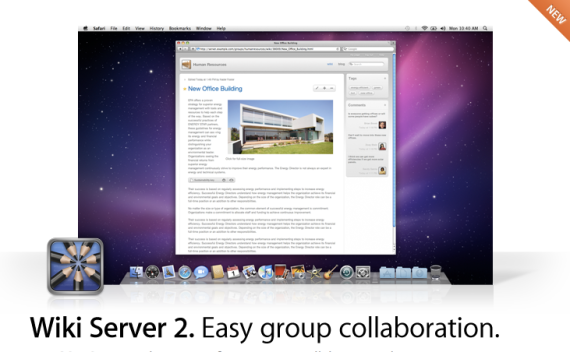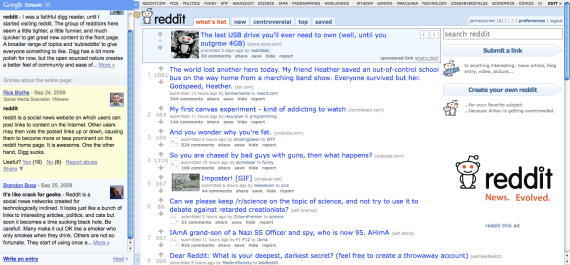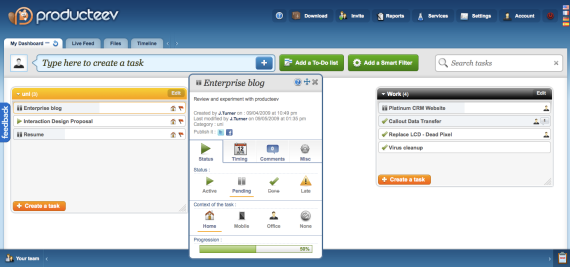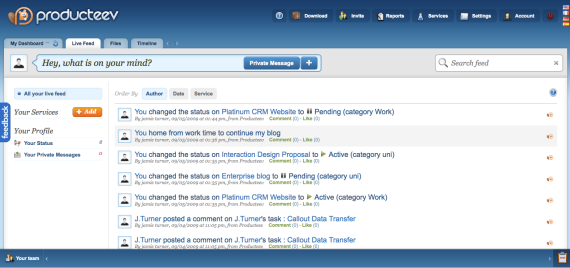Posts Tagged ‘Enterprise 2.0’
16
Oct
Posted by jamie turner in Enterprise 2.0, Reviews. Tagged: Apple, apple mac, blog, business, collaborate, Collaborative tools, enterprise, Enterprise 2.0, OS X, OS X Server, server, Tags, web 2.0, wiki. 1 comment
Last week I was browsing the apple website for software and came across some very interesting features in the new OS X Snow Leopard Server software. It appears apple have have made quite a large contribution to incorporating many collaborative tools into their enterprise product. I then attempted to do some research about how the company have recognised the importance of enterprise 2.0 however the information was very scarce. I couldn’t even find a blogger who has also noted this. So I decided to put it out there as an apple mac user myself to spread the word.
The main collaborative application included in OS X server is titled Wiki server, although contrary to the name suggests it does a lot more then just wiki’s. Apple advertise this simply as “Easy Group Collaboration”. From a collaborative business perspective, they offer the whole shebang. They primarily cater for enterprise level wiki and blog creation. All with fully customizable comments, tags and many other 2.0 goodies. Also they have pushed the idea of sharing information and building your brand by including ‘Podcast Producer’. Which makes recording, editing and publishing podcasts and vodcasts so quick and easy that anyone can do it! Many enterprises can benefit from this software and it is interesting to know the some of the big players are realising the importance of colaboration and including these tools in their enterprise software.

12
Oct
Posted by jamie turner in Enterprise 2.0, Reviews, web 2.0. Tagged: blog, collaborate, ego, Enterprise 2.0, google, help, kevin rose, sidewiki, social networking, web 2.0, wiki. 4 comments
Website annotation has been around for sometime now with services such as shadows, TrailFire, and Dingo but haven’t really taken off…Enter Google with their edition of website annotation titled SideWiki!
So what is it all about? Sidewiki allows any Google user to place comments on an entire page or even selected sections of a web page. These comments are listed in a retractable toolbar down the side of your browser. They have also included the option to embed images and videos into the comment however in my brief search I haven’t seen it done yet.
So how do they control things like spammers and flamers? The have used a ranking system where users can vote up or down on comments. Comments with more votes up directly affect that users ‘ranking’. Users with high ranking or reputation will be placed towards the top of the sidewiki hierarchy and low rating users will be stomped down to the bottom where no one will read them. In my opinion this sounds like an effective measure. Chris Doble talked about this concept in his recent post disscussing Kevin Rose’s suggestions for taking your site from one to one million users. Kevin suggested that giving users an “ego” to work on gives them an incentive to post good material and to get involved positively. Sidewiki has done that well because not only does one ‘flame’ take down that comments rating, it affects that users overall positioning on all other pages. This is a huge incentive to help other users and collaborate. Very Web 2.0 like.
So I took the liberty of giving SideWiki a go and had some pretty pleasing results. It’s not everywhere yet but found it in heavy use at TechCrunch and also at sites such as reddit. It seems to be currently used as a reviewing type system where users are saying, I use this website for this, it is good for this etc. I can see this being very useful if it is taken on by the wider public as a very, very helpful tool in research. Having short summaries and recommendations before you read an entire journal would be very beneficial to students and researchers in particular.
Overall it seems like a good thing, but like all web 2.0 tools you need people to come on board to get the ball rolling. The only strongly disappointing feature of Google SideWiki is…. it is bundled with Google toolbar (yes, the screen hogging, colourful pictures and auto-filling nightmare). Hence the reason why I am about to uninstall the add on and end my google SideWiki experience for now. Fingers are crossed that they will release a standalone add-on in the near future!
~Jamie

2
Oct
Posted by jamie turner in Enterprise 2.0. Tagged: adoption, business, Enterprise 2.0, Enterprise2, fear or change, risk, security. 2 comments
I have been doing a lot of reding lately about how companies have introduced web 2.0 into their business and the issues that they have come accross. Most seem to have the same types of adoption hurdles that are needed to be overcome. From what I have read I have formed my own opinons about what seems to be the three major issues with enterprise 2.0 adoption:
1. Fear of change
Many people fear change and this becomes especially revelant within the enterprise. incorporating new technologies into existing business processes can be met with resistance from employees and accommodates. Some even regard the switch to Enterprise 2.0 and a culture change within a business.
2. Losing ownership
The concept of creating a collaborative community can sometimes prove to be challenging to some. Personality types that desire to be the ‘head honcho’ especially can be resistant to passing on the ownership of roles to colleagues and others. shifting the responsibility to the whole rather than having the single opinion of a manager of IT department, this does prove to be confronting and can can tie in with the fear of change issue.
3. Privacy Issues
One of the concepts of web 2.0 especially is sharing information in ‘The Cloud’. Many people used to traditional communication tools such as email find this concept intimidating as they are putting themselves out there for everybody to see. Wiki’s, blogs and social networking all focus on sharing your opinions and creating networks between people by sharing information. Especially security conscious companies with confidential information can find it a challenge to maintain their privacy. In my opinion this is the biggest hurdle to overcome when adoption these technologies within the enterprise.
Forrester research produced some very interesting results lately regarding the adoption of E 2.0 within businesses. “90% of surveyed IT professionals and security decision makers reported that they are at the least “very concerned” about related threats and may have made the leap into these technologies without thinking about the security consequences.”
So what are some strategies to overcome these issues with adoption? Yuri Alkin has made some suggestions that I agree with. Knowing which enteprise 2.0 technologies are appropriate for your business is very important. Flooding a company with many new technologies that all do similar things or are unnecessary will be one the the easiest ways for employees to lose interest. He also suggested runing a pilot process to get initial feedback however I believe this should be expanded on by making the pilot an optional task for employees. Initially allowing the people who really want to help contribute, therefore creating a positive and productive community. This will then show the others the benefits and will encourage them to jump on the E2.0 wagon. Finally it is just as important to follow through with projects once they begin. Maintaining and adjusting to the needs of business as time progresses is very important because every business is different and the perfect enterprise solutions for a business can only be achieved over time after many cases of trial and error.
So what do you think are the main issues with Enterprise 2.0 adoption? what strategies can you suggest to help introduce new companies to the concept?
26
Sep
Posted by jamie turner in Enterprise 2.0. Tagged: BT, collaboration, Enterprise 2.0, entperpsie social networking, link, my BT, sharing, social network, web 2.0. Leave a comment
I’m quite sure we all know what social networking is… don’t we? You would be hard pressed to find someone who does not have a profile on myspace or facebook. I went out to ask what my friends thought of social networking and to discover what they primarily use it for. This is what they thought;
- To Keep in touch with friends
- View and share photos and experiences
- Discover new music (myspace Music)
- Show others what you’re interested in (facebook fan pages)
- Organising events
So this is what the average Joe thinks of social networking, but when you look at these points you can see the huge potential from the enterprise side. As an artist using social networking to get your new music out there would have to be the fastest, easiest and cheapest venture as opposed to standard advertising. The potential of reaching an audience that is already connected is massive, it provides the ability to hand pick the target audience and draw them in. That is the marketing side of using social networks in the enterprise. I will cover more on this in a later post. What I would like to focus on today is using social networking internally within an enterprise.
BT is a global company that provides communications solutions to more than 170 countries around the world. They have introduced a social network to its company title ‘My BT’, It possesses all the typical aspects of a social network that you would need. A contacts section(or ‘friends’) to link with your colleges. A profile message board to post comments and a ‘my personal FAQ’ section that allows colleagues to post questions about projects and other work related issues. It has integrated social bookmarking to share the employees tagged links as well as a newsfeed that displays activity on the profile. What struck me as something that is different from your standard social network was the integration of a ‘Skills and interests’ section on the page. Here you list your skill or interest, then a search is undertaken for all other employees with that same interest/skill and a group page is created where they can collaborate.
I was fascinated with this new concept on social networking. When I thought about it, it relates very much to the Extensions attributes of the SLATES paradigm by suggesting relevant content, but it takes a step further by connecting likeminded people and allowing them to share. One of the members behind the team responsible for creating the social network at BT, Richard Dennison, explains that it gives the employees incentives by allowing them to seek help from likeminded professionals and also to build your online brand. I think this is a fantastic way for web 2.0 tools such as social networking to be used within the enterprise and BT have definitely hit the nail on the head with this one. I think it has been executed very well and from what I can tell on Richard Dennison’s blog it has been adopted very well.
11
Sep
Posted by jamie turner in Enterprise 2.0. Tagged: blogging, collaboration, enterprise, Enterprise 2.0, Micro-blogging, twitter, web 2.0, wiki, wordpress, work. 5 comments
Back in my post titled So who is using it? I mentioned how I was starting to use a wiki in my workplace at Forest. Over the past few weeks I have trialed the wiki and some other Enterprise 2.0 tools, here are my first impressions on their adoption.
Wiki
I introduced a wiki as a reference where everyone in the workplace can contribute and get information when needed. This has been a success so far especially since the office is only small (usually 3 people at a time). The wiki has developed into more than what I originally intended. When I started the wiki I made some pages for ‘Repair Guides’, ‘Procedures’ and ‘Product information’. These three pages have been utilised well, having staff members contribute and use the wiki as the first place to look when seeking information. What I didn’t expect and what really shows the power of collaborative tools in the workplace was the creation of new pages, such as a Clients page and a Things to Do page. After only a few weeks it looks like the wiki is growing well and will prove to be an invaluable tool within Forest.
Micro-Blogging
I suggested to my colleagues that we should try to use twitter as a quick and easy communication tools within our workplace, 50% of us already had a twitter account and were familiar with the idea and all of us had iPhones so the potential was definitely there. We tried to use it as a reminder and notification system, for example; ‘@Jamiecturner you have an appointment at 12:00 with xxx at yyy street’. The problem with this was that it was often followed up by a call to get more information. Also when sending message within the office it seems pointless to send a tweet when we could walk 20m and the person face to face. My final thoughts on micro blogging in our small business : not suited.
So from the two Enterprise 2.0 mediums I have tried so far, one has proved a great success. I was thinking of using mash-ups next but am unsure of how it can specifically benefit us. Any suggestions are welcome, I have been looking at Yahoo Pipes so far and it looks like it has a lot of potential. What other Enterprise 2.0 methods can you suggest we try next?
~Jamie
6
Sep
Posted by jamie turner in Enterprise 2.0, Reviews. Tagged: business, collaboration, Enterprise 2.0, facebook, management, Micro-blogging, organisation, producteev, productivity, project management, review, tools, twitter, web 2.0, Yammer. 1 comment
Throughout my blogging I have found many web 2.0 tools being used used in the enterprise and even had a go at using some such a yammer, basecamp etc. Yesterday I stumbled across what i believe to be the best one so far, Producteev. It is an all in one collaborative project management tool with a very nice ‘web 2.0’ look and feel. It’s very user friendly with drag and drop features and very intuitive navigation.
So you create a task that appears as a rounded box in which to can add “To-do’s” inside the task. Within each of these you can set the description of the project or task, and also note the progress that has been made, status deadline and more. Also your colleagues can comment on the task to update progress or ask questions to other member of the team participating in the task.

Add tasks and view current projects in the dashboard
All of these tasks are then linked in with the “Time line” widget which integrates with your tasks panel. It has three views, the calendar view(pictured below) which really helped me to organise due dates for my current projects, you can also which to daily or weekly view which can show specific dealines and time and teh progress you have made towards them. I used the daily view at work to schedule my appointments and make sure I had planned the repairs so I didnt run out of time, and it worked really well.

Schedule tasks and review dealines in the timeline screen
The third part of producteev I thought was great was the live feed section. This shows you all the status updates of colleagues on tasks that have been set and also incorporates a micro-blogging concept as well. On top of this the notion of collaboration is reinforced by the option to collaborate and share on all tasks, feeds, posts etc. Integration with twitter and facebook also encourage sharing out public tasks to members of the community to let them know how your progressing on projects.

View status updates and also update your status in with the twitter like micro-blogging feature
Ontop of all the features I have covered there are still more, such as file upload and sharing, the ability to set public and private tasks, smart filter tasks and more. In my hour or so playing around with this I can only say it was a pleasant experience, it was a little buggy at times but this is only a very new product and can only improve with time. I’ve set up a student based account which allows up to 40 members in a team so if you would like to be invited let me know and we can test it out. There is only a certain amount of testing that can be done by myself. I can highly recommend Producteev as one of the better enterprise 2.0 tools i have experienced so far, with its multiple functions, integration with so many services and ease of use its definitely something to think about in your business or education group.
~Jamie
 ::
::  ::
::  ::
::  ::
::  ::
::  ::
::  ::
::  ::
::  ::
::  ::
::  ::
:: 
26
Aug
Posted by jamie turner in Enterprise 2.0. Tagged: customers, Enterprise 2.0, job, linkedin, marketing, revenue, sales, sales 2.0, web 2.0, web2. 1 comment

Hi all,
Sorry for having such a big break since my last post I have been really busy. I have come across all this material to discuss but never had the time to write about it. the focus of today though is on a document i found that addresses a new concept title sales 2.0. Much like enterprise 2.0, sales 2.0 is an adaption of web 2.0, or a way to use web 2.0 tools to specifically target sales and increasing sales revenue. To quote from the paper,
“Just as Web 2.0 is reshaping how consumers collaborate online, Sales 2.0 is transforming how companies go about the business of selling to their customers”
It summarises the key goals and perspectives on Sales 2.0 as:
Like Web 2.0, many of the tools, technologies and techniques of Sales 2.0 are being born of experimentation. As time progresses these tools are improved upon and re-engineered to suit the specific business or sales purpose. It helps salespeople do a better job of identifying leads, of turning leads into opportunities and of converting those opportunities into sales.
This was demonstrated in a case study which outlines which tools they used and how they used them. They state that one of the first steps taken was to build their own brand and concept that crosses with Enterprise 2.0 and is discussed regularly on rockthejob.com. This was done by creating a wordpress blog, as i have done, and using facebook and twitter to attract traffic to the blog. New sites that i have yet to experience were noticed such as Vestopia and Stockpickr, these were used to create online portfolios and submit these to investors who had the same interests. From my initial impressions these tools look very useful, providing similar concepts to linkedIn but with their own unique additions. Meetup was also used to manage and communicate with seminars that were being held.
The key steps that were used in this Sales 2.0 scheme are roughly as follow:
- Begin building an online brand using tool such as the ones previously discussed
- Get future clients to read the material that is published online
- Encourage these clients to make contact on a personal level by using e-portfolios such as Vestopia or LinkedIn
- Use these clients to the spread your brand and generate more clients by using services that allow recommendations, re-tweets on twitter and many more.
Overall there are many similarities between enterprise 2.0 and sales 2.0 but this shows how these web2 technologies are flexible and can be adapted to target specific business and customers or even to suit a purpose. I highly recommend reading the full document here as it give a deeper analysis into the sales2.0 concept and how it is used.
On a similar note i have begun to use the delicious bookmarking service, i will discuss my experiences in a later blog but you can view my Enterprise 2.0 links that will grow with time at http://delicious.com/jamiecturner/enterprise2.0
until next time,
~Jamie
 ::
::  ::
::  ::
::  ::
::  ::
::  ::
::  ::
::  ::
::  ::
::  ::
::  ::
:: 
15
Aug
Posted by jamie turner in Enterprise 2.0. Tagged: adopting, banking, blog, business, Enterprise 2.0, services, tools, web 2.0, web2, wiki. 8 comments
So far i’ve been talking about what is out there to be used and how it can be used. This week i set out to find who is actually using these technologies, in particular i tried to find some australian examples. To my surpirise i was having some trouble finding information on some large companies using web 2.0 tools regularly but i did find some results.
RaboPlus, an australian bank currently are using web 2 tools such as podcasts and blogs, as a way to communicate with their customers. You can view the community pages at http://www.raboplus.com.au/investor_centre. They use it as a way to communicate with their customers on a regular basis to give them up to date information. (This information was found at OnlineBankingReview).
Another Australian company Chochlear use a wiki internally to spread information to its engeneering team and also to keep staff up to date with current project status.
Cochlear software development manager Victor Rodrigues says it has changed the way the company works.
“People are a lot more aware of things that are happening around them just by the mere fact that anyone can go to a wiki and publish information internally. Its use certainly has picked up.
“Over the past two months, for example, the number of contributors has increased by almost 100 per cent,” Rodrigues says.
(found at australianit.news)
Over the past weeks of researching enterprise 2.0 i have been developing ideas of how this can help me at my workplace and started putting them into action. For those who don’t know i work at forest computers, we deal with apple computers, repairs, web development, networking, voip, security and many more IT related services. This is a small business so i am usually chopping and changing between these areas and it often becomes confusing. So i have created a wiki to be used by the staff. The reason for this was to have a place where all staff can go to reference all the services and processes that need to be done in the business. For example we had a staff member who specialised with dealing with iphones and vodafone contracts. When he left, the rest of the company was left relatively in the dark as to where to pick up where he left off. With the inclusion of a wiki it can be a place where all the processes that need to be done to sign up a customer contract for example could be so we can have access to the information if ever needed. I have spoken my colleuges and they all agree that a wiki would be a great addition to the company and some have already began contributing. I will keep you guys updated as to how the wiki is adopted in the company and my thoughts on its effectiveness but so far so good.
These example show the power and versatility of web 2.0 tools, the same tools can have different applications in different companies and reap many kinds of benefits. In my opinion incorporating enterprise 2.0 in your business means that you are engaging your employees and encouraging them to get involved. Tomorrow i will continue this post by further analysing the use of enterprise 2 by these companies and how these cases relate to patterns developed by Dion Hithcliffe and Andrew McAfee.
Until then, do you know of any other Australian companies embracing web 2.0 tools?
~Jamie
11
Aug
Posted by jamie turner in Enterprise 2.0. Tagged: best buy, dell, Enterprise 2.0, Enterprise2, ford, forrester, promotion, samsung, social network, starbucks, twitter, web 2.0. 5 comments
In my previous posts i outlined some of the many web 2.0 tools that can be used for personal use and in the enterprise. Now i am going to focus mainly on twitter in this short article. For those who don’t know, twitter is a micro-blogging service that allows people to update their status or send messages in no more than 140 characters. So how can this have any benefits to business? I think its easier if i give some examples
- Samsung have a twitter account dedicated to their mobile phone range. they disscuss feature, promotion and customer issues using this service to reach a large amount of people. You can view the samsung account here twitter.com/SamsungMobileUS
- Ford also use twitter as a place customers can contact them and get a quick short response or point them in the right direction. twitter.com/FordCustService
- Starbucks posts offers and the latest deals on their twitter account twitter.com/mystarbucksidea
Others such as forrester, best buy, dell and more use this service as a way provide customer service, increase awareness, spread news and promotion and create a network of customers. The benefits are huge for a small price of 140 characters and businesses in australia should also try to harness this technology.
Let me know if you know of any other businesses using twitter and what do they use it for?
**Insert Plug** Also you can follow me on twitter at www.twitter.com/jamiecturner
~Jamie



















